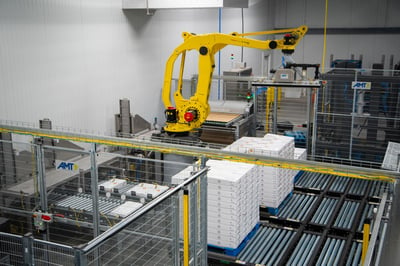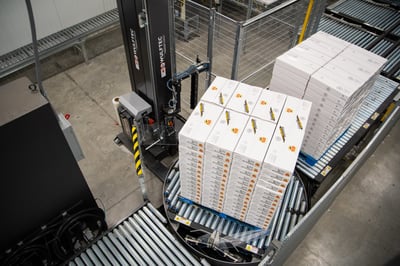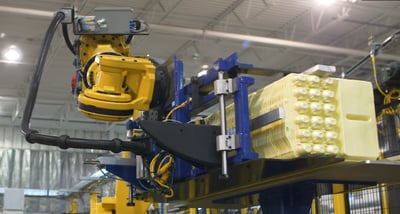From Depalletizing Product at the Front of Your Line to Palletizing Downstream, Material Handling Automated Solutions Efficiently Transport Materials In and Out of Your Manufacturing Process
Automated palletizing and depalletizing are critical upstream and end-of-line operations in a wide variety of industries, including warehousing and logistics, food and beverage, aerospace, automotive, and more. Designing and implementing robust robotic material handling solutions is far from one-size-fits-all.
Material handling is a broad category of automation that can be as simple as moving parts from point A to point B, such as on a basic conveyor, or as complicated as a high-speed robot tending multiple conveyor lanes, sorting a variety of products (e.g., by type, customer, or order number), and building those products layer by layer into specific pallet patterns.
What are Palletizing and Depalletizing?
Two of the most common processes in material handling are palletizing – stacking boxes, cases, or finished product onto a shipping pallet for safe transportation, and depalletizing – removing items from a shipping pallet, sometimes referred to as singulation or decanting. Compared to having an operator complete these functions, palletizing and depalletizing are areas where automation can make a positive impact on the bottom line by offering significant cost savings while protecting operators from potential repetitive motion injuries.
|
Contact an AMT Material Handling Expert Today |
With nearly two decades of successfully completed robotic material handling projects under our belt, AMT has developed a methodical checklist for evaluating the unique parameters of each project to design the most cost-effective and efficient automated solution for our customers.
Download: 10 Key Considerations for Palletizing / Depalletizing
Robotic and Automation Integration
Palletizing and depalletizing equipment is often integrated with upstream and downstream processes such as these:
For palletizing
- Case erecting
- Packing
- Sealing
- Labeling
For depalletizing
- Unitizing
- Row picking
- Layer picking
Although palletizing and depalletizing are most often conducted with boxes, specialty equipment can be designed to handle other loads such as bags, trays, cases, sheets, totes, and pails (think of sand, rice, or pet food).
A full-service system integrator will use a holistic approach to the design of robotic systems, and make recommendations to ensure the entire process meets the client’s production and business goals. To ensure the design of a robust automated system, a detailed process analysis must first be conducted, laying out the upstream and downstream processes to handshake with. Various technologies are employed to complete the required palletizing or depalletizing task, most often including robotics and vision systems. Often the scope is changed to include adjacent operations and their respective equipment to avoid creating new bottlenecks at interfaces. This full scale evaluation can be the difference in implementation of automation to create value for production systems.
Video: End-of-Line Robotic Palletizing Solution for the Protein Market
Engineered Solutions for Material Handling Challenges
Material handling difficulties come in three basic types: challenges with the production environment, such as a cold area with food-grade equipment, challenges with the product, such as odd shapes, sizes or centers of gravity, and challenges with the process that require highly adaptable systems, such as mixed-load capabilities.
AMT has a long history of successful material handling projects,” said Vice President of Sales Rick Vanden Boom. “Two of our most recent projects had unique challenges and were very financially rewarding for our customers. They have been so successful that AMT has been contracted to complete multiple lines in multiple plants.” Working in a broad array of industries has given AMT a solid base of knowledge to design systems to meet unusual manufacturing challenges.
Environmental Challenges
The condition of a production facility often contains hidden challenges for automation and needs to be considered in the beginning stages of design. Sometimes this is as evident as an uneven floor or older concrete that does not meet today’s construction standards for heavy equipment. There can be utility concerns with the air and electrical needs for automation that need to be considered in planning both the hardware content and auxiliary components needed to supply equipment. One of the more difficult parts to assess may be the general structural layout and its ability to house large scale automation in a functional way. When buildings are not designed with these types of systems in mind there can be unique layout challenges for fit and function of robotic and other automation.
Ambient temperature, humidity and potential temperature fluctuations are just a few of the many environmental factors that can affect automated equipment performing palletizing and depalletizing processes. Extreme conditions require a careful selection process for all hardware design considerations. Different components will be suited to conditions in a forging operation compared with a refrigeration area where food products are handled. There may be added protective equipment and modified preventative maintenance plans that need to be considered as well. Conditions are often harsh for both operators and equipment in these types of plants and design challenges abound. In a recent project AMT designed several automation systems to handle boxed frozen meat product for a meat distribution company. Most of these systems focused on palletizing operations of product cases, but there were also systems to handle freezing stack manipulation, empty box transport, and general material conveyance. Hardware selection was an important part of the design process to work within the temperature condition and the facility structural design that is required to control those conditions. There were also unique challenges of designing automation into a production area that still houses many manual operations and to comply with food grade equipment standards in these areas.
Video: Conveyance and Robotic Palletizing – Wolverine Food Packaging
Product Challenges
Several of the items in our 10 Tips for Palletizing download relate to product-specific characteristics that can make palletizing a challenge, such as the product’s weight, porosity, center of gravity, and deflection when lifted. These traits greatly affect the design of the material handling equipment’s end-of-arm tooling (EOAT). This is further complicated by systems that need to incorporate a variety of packages with ranges of size and shape. Any parameters that fluctuate or are not predictable present challenges for automation to handle.
Design of product handling devices must account for all ranges of product characteristics that are meant to be processed through a system. From the beginning stages of concept, automation design has to plan to adapt within these specifications and how to handle unexpected results. The basis of this design will direct the controls programming needs in order to manage the product presentation to automation. The limitations of equipment capability also need to be documented in the process operation information for future reference.
AMT recently completed a project handling a thermoformed (Styrofoam) product, with all the manipulation difficulties associated with that material. The pack out process was fed by a high-speed continuous-motion printing process. Once printed, the system created measured stacks and compressed them to a specific length before a robot created pallets of the product, then stretch wrapped and labeled them before they left to be staged for shipment. This product material exhibits high variation and required tool design and programming to handle high variation and promote stability as it was processes through the system.
Article: Revamped HMI Provides Better Process Control for Material Handling System
Video: Thermoform Product – Robotic Material Handling and Palletizing
Process Challenges
Some manufacturing processes are completely unique and their automated systems require adaptability to meet production requirements. AMT has successfully engineered many such systems, each customized to meet the particular needs of the manufacturing situation following a through process analysis. A wide variety of technologies can be employed to efficiently and creatively assist the client in meeting their manufacturing goals, such as robotics and smart, flexible 2D/3D vision technology.
Investment in automation can provide flexibility for now and in the future. For palletizing operations we want to be able to adjust to changes in upstream and downstream processes. Technology can be used to play a role in part identification, tracking and other management tasks that help systems adapt, including equipment like RFID, barcode scanning, and vision systems. Smart system programming can make decisions on how to handle product and support operations like multi-lane tending, mixed product sortation, and pattern strategy.
One of those projects was taking heavy cases of product from multiple production lines and sorting them by customer then by product and building pallets to ship to a customer to fulfill specific orders. One robot handles from one to several packages at a time, stacking them in a specific pattern on the pallet until it is full, known as row and layer forming. The full pallet goes through a stretch-wrapping operation and then moves out to shipping docks to be sent to the customer.
Case Study: Fiberglass Manufacture Line Automation Upgrade
Next Generation of Systems: Decanting and Mixed-Load Depalletizing
In addition to projects that handle one or two types of products, AMT is involved with leading-edge development of the next generation of material handling systems. The newest systems are designed to solve limitations which have a difficult time handling multiple types of product on one system. Currently, the process of mixed-load palletizing – efficiently loading boxes of different sizes, shapes and weights onto shipping pallets – is fraught with difficulties. Many manufacturers currently use human operators for this function, which can be hard on the operators (ergonomics) and on the company’s bottom line. With upstream automation in place in many facilities, the speed at which pallets must be loaded may require the use of what seems like an army of operators.
When designing palletizing automation for larger warehouse operations, there can be thousands of stacking  combinations based on the size of the product. These projects require expert-level programming of the equipment’s control system due to the large variation in the ways the robot is interacting with the product. Using preprogrammed algorithms, the robot will build interweaving patterns layer by layer (layer forming) to create pallet stability and most efficiently stack the product for shipment.
combinations based on the size of the product. These projects require expert-level programming of the equipment’s control system due to the large variation in the ways the robot is interacting with the product. Using preprogrammed algorithms, the robot will build interweaving patterns layer by layer (layer forming) to create pallet stability and most efficiently stack the product for shipment.
Mixed-load depalletizing – unloading boxes of different sizes, shapes and weights – also has inherent challenges. The many different items on the pallet may need to be sorted and distributed to separate locations, and there are complicated decisions to be made that could be a struggle for an operator, especially if the line is running at high speed. Adding robotic depalletizing equipment to a facility such as this can often have a quick return on investment (ROI).
Material handling solutions which include palletizing and depalletizing can be complicated, but when thoughtfully designed and installed can provide a quick ROI and a reduction in risk. Please contact AMT for more information or to discuss your project.
Interested in exploring automated palletizing and/or depalletizing solutions?
Contact an experienced AMT expert today!

